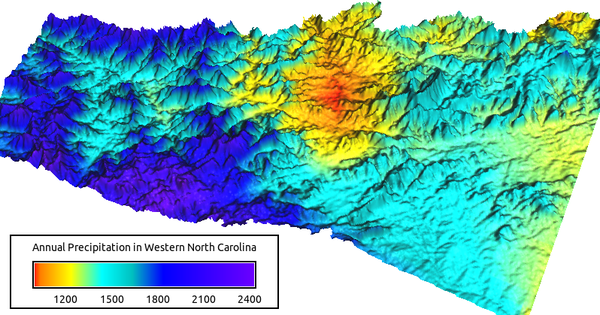
Note: This addon document is for an older version of GRASS GIS that will be discontinued soon. You should upgrade your GRASS GIS installation, and read the current addon manual page.
NAME
v.surf.tps - Performs thin plate spline interpolation with regularization and covariables.KEYWORDS
vector, surface, interpolation, TPSSYNOPSIS
Flags:
- -c
- Input points are dense clusters separated by empty areas
- --overwrite
- Allow output files to overwrite existing files
- --help
- Print usage summary
- --verbose
- Verbose module output
- --quiet
- Quiet module output
- --ui
- Force launching GUI dialog
Parameters:
- input=name [required]
- Name of input vector point map
- Or data source for direct OGR access
- layer=string
- Layer number or name
- Vector features can have category values in different layers. This number determines which layer to use. When used with direct OGR access this is the layer name.
- Default: 1
- column=name
- Name of the attribute column with values to be used for interpolation
- If not given, z-coordinates are used.
- smooth=float
- Smoothing factor
- Default: 0
- overlap=float
- Overlap factor <= 1
- A larger value increase the tile overlap
- Default: 0.1
- min=float
- Minimum number of points to use for TPS interpolation
- Default: 20
- covars=name[,name,...]
- Name of input raster map(s) to use as covariables
- Name of input raster map(s)
- thin=float
- Point cloud thinning factor in number of cells of the current region
- Minimum distance between neighboring points for local TPS interpolation
- Default: 1.5
- output=name [required]
- Name for output raster map
- mask=name
- Raster map to use for masking
- Only cells that are not NULL and not zero are interpolated
- memory=integer
- Memory in MB
- Default: 300
Table of contents
DESCRIPTION
v.surf.tps performs multivariate thin plate spline interpolation with regularization. The input is a 2D or 3D vector points map. Values to interpolate can be the z values of 3D points or the values in a user-specified attribute column in a 2D or 3D vector map. Output is a raster map. Optionally, several raster maps can be specified to be used as covariables which will improve results in areas with few points. The module can be regarded as a combination of a multiple regression and spline interpolation.The min options specifies the minimum number of points to be used for interpolation. If the number of input points is smaller than or equal to the minimum number of points, global TPS interpolation is used. If the number of input points is larger than the minimum number of points, tiled local TPS interpolation is used. Tile sizes are variable and dependent on the extents of the min nearest neighbors when a new tile is generated.
The smooth option can be used to reduce the influence of the splines and increase the influence of the covariables. Without covariables, the resulting surface will be smoother. With covariables and a large smooting value, the resulting surface will be mainly determined by the multiple regression component.
The overlap option controls how much tiles are overlapping when the min option is smaller than the numer of input points. Tiling artefacts occur with low values for the min option and the overlap option. Increasing both options will reduce tiling artefacts but processing will take more time. Values for the overlap option must be between 0 and 1.
The module works best with evenly spaced sparse points. In case of highly unevenly spaced points, e.g. remote sensing data with gaps due to cloud cover, the thin option should be used in order to avoid tiling artefacts, otherwise a high number of minimum points and a large overlap value are required, slowing down the module.
The memory option controls only how much memory should be used for the covariables and the intermediate output. The input points are always completely loaded to memory.
EXAMPLES
The computational region setting for the following examples:g.region -p rast=elev_state_500m
Basic interpolation
Interpolation of 30 year precipitation normals in the North Carlolina sample dataset:
v.surf.tps input=precip_30ynormals_3d output=precip_30ynormals_3d \
column=annual min=140
Interpolation with a covariable
v.surf.tps input=precip_30ynormals_3d output=precip_30ynormals_3d \
column=annual min=140 covars=elev_state_500m
Interpolation with a covariable and smoothing
v.surf.tps input=precip_30ynormals_3d output=precip_30ynormals_3d \
column=annual min=140 covars=elev_state_500m smooth=0.1
Tiled interpolation with a covariable and smoothing
v.surf.tps input=precip_30ynormals_3d output=precip_30ynormals_3d \
column=annual min=20 covars=elev_state_500m smooth=0.1 \
overlap=0.1

Precipitation computed based on annual normals and elevation as a covariable
REFERENCES
- Hutchinson MF, 1995, Interpolating mean rainfall using thin plate smoothing splines. International Journal of Geographical Information Systems, 9(4), pp. 385-403
- Wahba G, 1990, Spline models for observational data. In CBMS-NSF Regional Conference Series in Applied Mathematics. Philadelpia: Society for Industrial and Applied Mathematics
SEE ALSO
v.surf.rst, v.surf.rst, v.surf.idwAUTHORS
Markus MetzSOURCE CODE
Available at: v.surf.tps source code (history)
Latest change: Mon Jun 28 07:54:09 2021 in commit: 1cfc0af029a35a5d6c7dae5ca7204d0eb85dbc55
Note: This addon document is for an older version of GRASS GIS that will be discontinued soon. You should upgrade your GRASS GIS installation, and read the current addon manual page.
Main index | Vector index | Topics index | Keywords index | Graphical index | Full index
© 2003-2023 GRASS Development Team, GRASS GIS 7.8.8dev Reference Manual